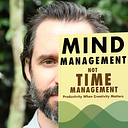The Alternating Incubation Method of Getting Art Done
Incubation is critical to achieving creative insights. When you aren’t consciously working on a creative problem, your unconscious mental processes are working on the problem. Numerous studies have demonstrated that incubation periods improve creative problem-solving.
But when you need to create multiple smaller pieces in a short amount of time, you can use the Alternating Incubation method.
Imagine you need to write an article, and an intro script for a podcast episode, all within two hours. Your session might look something like this.
Here’s how it works:
- The different phases of the two projects are alternated, which allows for unconscious incubation of one project while working on another.
- When returning to a project, the incubation period should have made it easier to solve any problems you might have encountered in the previous session.
- The progression of activities, from brainstorming, to drafting, polishing, and finalizing, allows for mental warm-up throughout the session.
- The progression of activities avoids costly mind-state switching. Instead of having to go straight from proofreading an article (which requires attention to detail) to brainstorming a podcast intro (which requires expansive thinking), activities are grouped together by mind-state.
While this session plan could be taken literally, there are a few things to keep in mind:
- Creative projects are rarely so linear. Sometimes, pieces of completed prose come to you, sometimes an outline structure. Your creative momentum is more important than following a rigid structure.
- Depend upon your skill level, and the creative complexity of the deliverable, you may be able to switch more nimbly between stages of a project. You may brainstorm, draft, and polish all in one go, though it’s likely you’ll benefit from the incubation session before finalization.
- This session is two hours, but the breaking up of these phases of projects could span an entire day, multiple days, or weeks or months. The more daunting the creative challenge, the more you’ll benefit from extended incubation periods.
Pay attention to the mental effort it takes to make it through the various phases of a creative project. Also, notice how incubation periods make it easier to bust through creative blocks. Arrange your work accordingly, and you can do more work, and better work, in a shorter amount of time.
Getting Art Done will boost your creative productivity, so you can finally make your masterpiece. Sign up for updates.
